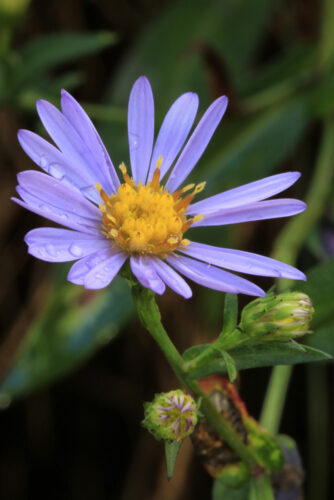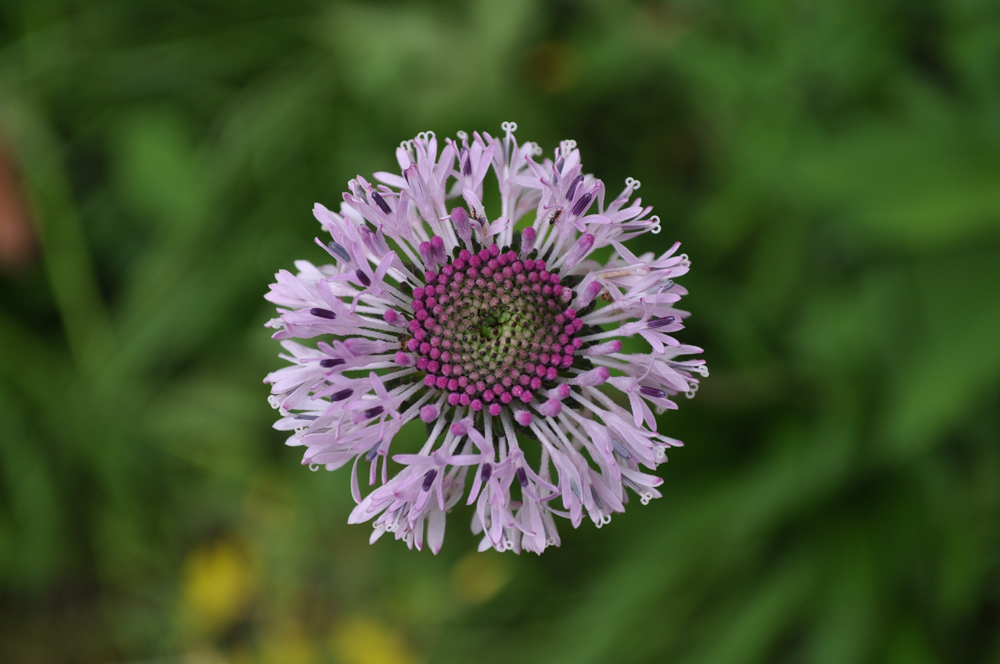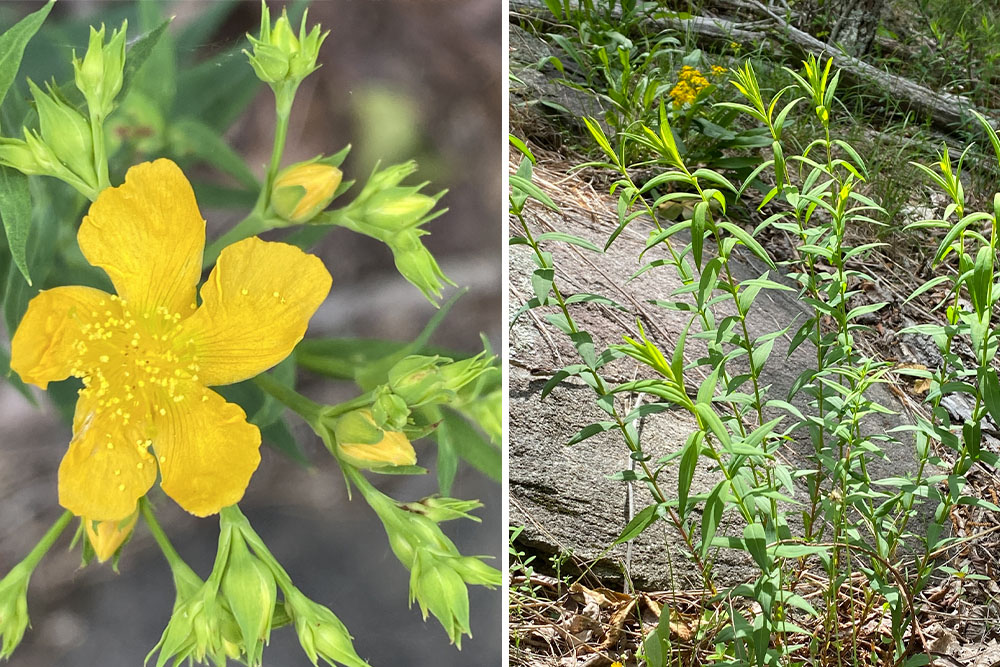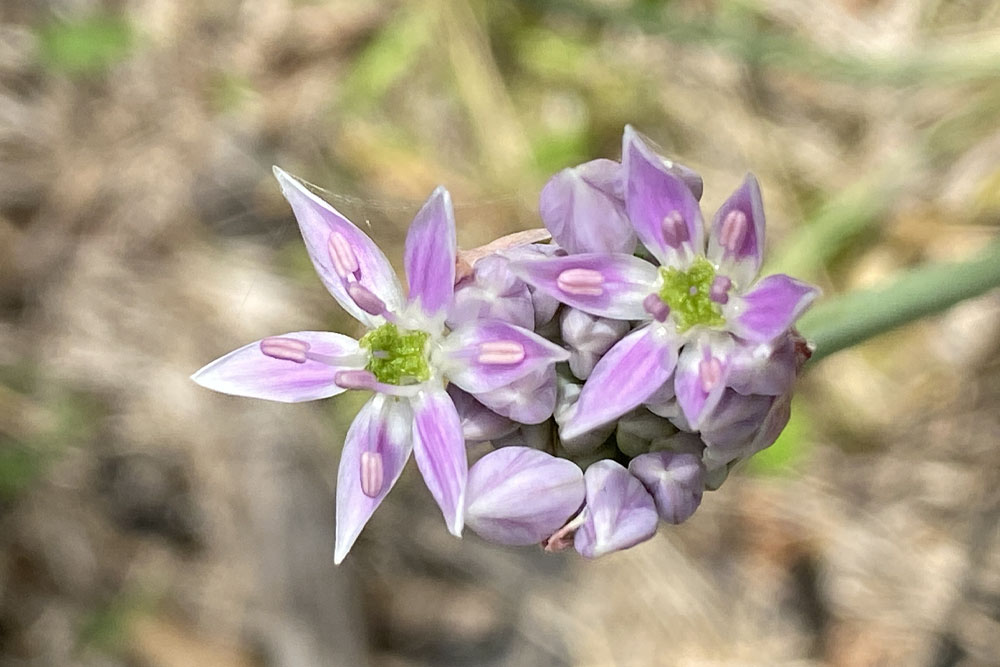Drive five hours west of Chapel Hill to Nantahala National Forest, and you’ll find a patchy mountainside comprised of open woodland and dense grasslands bursting with plant species that don’t exist anywhere else in the world.
In other words, it’s a botanist’s dream — and why Laura Mansberg Cotterman chose the site for her master’s thesis in the 1980s. During that time, the N.C. State graduate student hoped to identify every plant in this area, called Buck Creek Serpentine Barrens.
Then she came across a purple flower with a bulging marigold center. It looked like an aster, but she couldn’t identify it. After talking to experts, it seemed like this might be a new species, though they weren’t sure.
Fast-forward to 2003, when Cotterman’s colleague — UNC-Chapel Hill biologist Alan Weakley — brought his wife, daughter, and botanist friends to the barrens. As they made their way up the trail, a frustrated 1-and-a-half-year-old Rhiannon Weakley shouted in dismay. In response, the group paused and sat down, giving her some space to work through her meltdown.

Symphyotrichum rhiannon or Rhiannon’s aster (photo by Alan Cressler)
While she did, Weakley and his fellow botanists unearthed the curiosity of Cotterman’s unidentified aster. They started volleying questions about the species back and forth.
Did Laura ever confirm if it’s a new species? What do we know about it? Have you done any work with it since? So, what are we going to do about this, Alan?
They decided it was their duty as botanists to carry the investigation forward. After two years of pursuing an answer, they made a discovery.
Fast-forward to 2024. The now 22-year-old Rhiannon has a tattoo of the dainty purple flower on her arm. Called Symphyotrichum rhiannon or Rhiannon’s aster, the new species was officially recognized in 2004 thanks to Weakley’s help — and Rhiannon’s tantrum.
“Geography is destiny,” declares Weakley, who is also director of the UNC Herbarium, managed by the North Carolina Botanical Garden. “Where you have a rare or unique habitat, it’s likely that there are going to be unique species there as well.”
About 10% of the southeastern United States’ 8,000 native plant species have been identified in the last 50 to 60 years, according to Weakley. That number aligns with global estimates, which suggest that nearly 10% of plants in the world remain undescribed.
In July 2023 alone, Weakley, his fellow researchers in the UNC Herbarium, and colleagues at other institutions in the region identified 10 new plant species across the Southeast.
“Most people think new plants are only discovered in exotic places like the Amazon, but many are discovered right here in our backyards,” Weakley shares. “Biodiversity science of this kind has been going on for centuries, yet there is so much still to discover. And these discoveries help us understand and conserve the ecosystems around us — how they evolved and how they can continue to thrive in a time of global change.”
Step 1: identification
Weakley has spent his career cataloging the plants of the Southeastern U.S. — from Pennsylvania to Florida to the eastern part of Texas and Oklahoma. He has documented this work in an identification guide called “Flora of the Southeastern United States.”
For Weakley, identifying new species usually happens in one of two ways: He sees something he’s never seen before while conducting fieldwork, or he stumbles across an old specimen — usually in the herbarium — that stands out from the other plants it’s been paired with. Herbaria, repositories of specimens gathered over the centuries, serve as foundations for the discovery of new species.
Aside from physical attributes, new species are identified by synthesizing information on breeding patterns, blooming season, habitat, and DNA sequencing. To officially declare something as “new,” researchers must document this information in a paper with images, publish it in a reputable scientific journal, and deposit a representative specimen in an herbarium.
“A new species is a scientific hypothesis that needs to be exposed to the criticism, acclamation, and agreement or disagreement of your peers,” Weakley explains.
Step 2: naming
Plants have two names: scientific and common. The scientific name is always in Latin, considered the “language of science” when biologist Carl Linnaeus developed his approach to biological classification in the 1700s.
Common names are more informal and are often created by the people who live in the regions where the species grow. Some plants have multiple common names.
For example, “rose” is the common name of the Valentine’s Day favorite, while Rosa rubiginosa is a scientific name of one species of rose. Dianthus caryophyllus is the formal name for “carnations,” which are also often referred to as “clove pinks.”
“Common names are a whole other world that science doesn’t deal with much,” Weakley says. “But people like us at the North Carolina Botanical Garden believe deeply in communicating the science to the broad public and recognize that Latin names aren’t ideal for that.”
In the last two decades, North Carolina Botanical Garden researchers have uncovered multiple new species in North Carolina and across the Southeast. Below, Weakley shares a few and the stories behind their discovery.
Marshallia legrandii | Oak Barrens Barbara’s-Buttons | N.C. & VA | 2012

Marshallia legrandii or Oak Barrens Barbara’s-Buttons (photo by Emily Oglesby)
Alan Weakley: In 1961, former UNC Herbarium Director Al Radford collected these stunning purple flowers in a dry woodland in Granville County, North Carolina. At the time, he thought it might be a species often found in bogs and dry barrens near Asheville and from river margins in the Appalachian Mountains of Pennsylvania, West Virginia, Kentucky, and Tennessee.
Over two decades later, Harry LeGrand — a biologist for the North Carolina Natural Heritage Program — disagreed with Radford’s original assessment. After studying the specimens with close observations in the field, he determined these plants were not part of the mountain species, nor could they be included in the typical Piedmont species known as Marshallia obovata. They differed in flower color, blooming time, and leaf shape and size, among other features.
In 2012, herbarium researcher Derick Poindexter and I conducted additional research and decided to name the species to commemorate LeGrand’s role in recognizing the distinctiveness of the plant. It was included in “Flora of the Southeastern United States” and was also found in south-central Virginia. With only two populations worldwide, this species is one of the rarest plants anywhere.
When an opportunity developed to purchase a large block of land in Virginia to help secure this species’ future, a conservation philanthropist stepped forward and purchased the 7,500-acre tract and donated it to the Virginia Department of Conservation.
Hypericum radfordiorum | Radfords’ St. John’s-wort | N.C. | 2011

Hypericum radfordiorum or Radfords’ St. John’s-wort (photos by Carol Ann McCormick & Alan Weakley)
AW: A distinctive St. John’s-wort grows on granite domes in the Brushy Mountains of the western Piedmont of North Carolina in Alexander, Caldwell, and Wilkes counties. In a 1980 dissertation, David Webb discussed that the populations of Hypericum in this area, first collected by Al and Laurie Radford in the 1930s, were difficult to assign to species. Jim Allison and I studied the plants and carefully determined that they represented an undescribed species, named in 2011 in honor of the Radfords.
Allium keeverae | Keever’s onion | N.C. | 2017

Allium keeverae or Keever’s onion (photo by Alan Weakley)
AW: The same set of granite domes in the Brushy Mountains produced another new species, a pink-flowered onion that had been included in a species of onion with white flowers and restricted to the Coastal Plain from South Carolina southward. UNC-Chapel Hill undergraduate Parker Williams, Poindexter, and I collaborated on the research to prove the species status — which they named in honor of Catherine Keever, a renowned ecologist who grew up in the area and studied the outcrops there.


